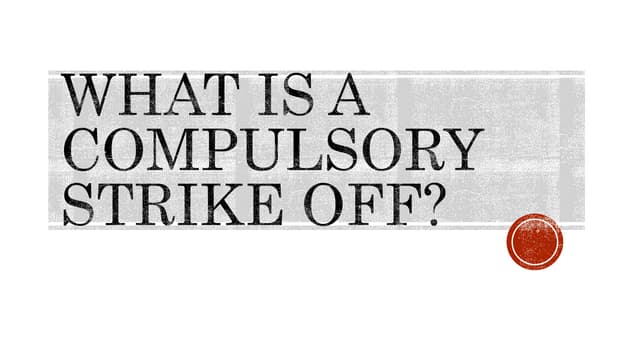Thorough Insights into Compulsory Strike Off Procedures
Thorough Insights into Compulsory Strike Off Procedures
Blog Article
A Comprehensive Guide to the Compulsory Strike Off Treatment in Corporate Governance
Browsing the complex landscape of company governance needs a keen understanding of the procedures that govern the dissolution of entities. The mandatory strike off procedure, a crucial component in company administration, offers as a system to enforce conformity and keep the stability of business atmosphere. As companies develop and scenarios change, the demand to strike off a company may occur for different reasons. Discovering the details of this process, including the legal ramifications, procedural actions, and post-strike off considerations, supplies invaluable insights for stakeholders seeking to browse the complexities of company administration.

Reasons for Compulsory Strike Off
There are numerous crucial reasons that might trigger the initiation of a mandatory strike off treatment for a business. Non-compliance with regulative requirements can increase concerns about the business's operations and economic health and wellness, leading to the choice to strike off the business from the register.
Additionally, firms that have actually ceased trading or are no more lugging out any type of service activities might likewise face compulsory strike off. This can be as a result of insolvency, mergings, or just a choice to wind up the firm. In such cases, maintaining the firm on the register would offer no objective and might possibly produce complication among stakeholders.
Eventually, the need of a required strike off in business administration occurs when a company is no more running based on the legislation or has actually ended up being obsolete, necessitating its elimination from the authorities documents.
Lawful Ramifications and Threats
Given the conditions that trigger a required strike off in business administration, it is necessary to recognize the legal effects and risks related to such actions. When a business is struck off the main register, it ceases to exist as a legal entity. This can have severe effects for supervisors, investors, and creditors. Directors may face personal responsibility for company financial obligations incurred after the dissolution, exposing their assets to possible seizure. Investors lose their investment in the company, and financial institutions may find it challenging to recover debts owed to them.
Moreover, there are lawful effects for people included in the monitoring of a company that has actually been by force struck off. Additionally, the reputational damages from a compulsory strike off can have enduring results on individuals and their capability to involve in future company endeavors.
Action In the Strike Off Process
Launching the compulsory strike off procedure in company governance includes a collection of prescribed steps detailed by governing authorities. The initial step generally calls for the company to send a formal application or alert to the appropriate federal government firm or registrar signaling its intent to be struck off the main register. Subsequently, the firm is usually needed to clear up any impressive responsibilities, debts, or tax obligations to make certain conformity with regulatory requirements.
Once the initial documents is submitted and monetary responsibilities are fulfilled, the governing body will certainly publish a notice in a similar magazine or the main gazette to educate stakeholders concerning the upcoming strike off - what is compulsory strike off. This notice acts as a final possibility for any kind of interested events to increase objections or present legitimate reasons that the business must not be dissolved
Complying with the publication of the notification, the governing authority will proceed with the strike off process if no substantial objections or barriers develop. The business will after that be officially liquified, and its name will be removed from the register, effectively noting the final thought look at this now of the mandatory strike off procedure in company administration.
Files Needed for Strike Off
In compliance with regulative guidelines, certain documents has to be provided to facilitate the strike off process in corporate governance. Additionally, economic declarations, such as the firm's newest equilibrium sheet, need to be consisted of to guarantee that all economic commitments have been cleared up prior to initiating the strike off procedure. It is vital to make certain that all the requisite documentation is diligently prepared and submitted in conformity with the recommended standards to expedite the strike off process successfully.
Post-Strike Off Considerations and obligations
Following the conclusion of the needed paperwork for strike off, attention changes to the post-strike off commitments and factors to consider that are crucial in the corporate governance process. As soon as a company has actually been struck off the register, it is important to make sure that all remaining assets are taken care of appropriately. This consists of dispersing any type of continuing to be funds among shareholders and resolving any kind of outstanding debts or responsibilities. In addition, company directors should make sure that all tax obligations are met, last worker payments are made, and that all necessary filings are completed with pertinent regulative bodies.

Final Thought
To conclude, the obligatory strike off procedure in business governance functions as a required system to get rid of obsolete firms from the register. Understanding the reasons, lawful ramifications, actions, and papers needed for strike off is critical for conformity with regulatory needs. It is very important for business to meet their post-strike off obligations and think about the Check This Out implications of this procedure in order to preserve great standing and avoid possible threats.
There are a number of crucial reasons that may trigger the initiation of a mandatory strike off procedure for a business (what is compulsory strike off). Non-compliance with governing needs can increase worries concerning the business's operations and financial wellness, leading to the choice to strike off the company from the register

Report this page